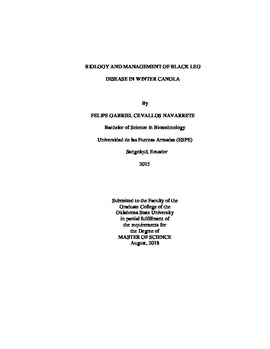| dc.description.abstract | The fungus Leptosphaeria maculans is the causal agent of black leg disease in canola (Brassica napus). The best strategy to control this disease is the use of genetic resistance. Two types of resistance are described. Quantitative resistance is controlled by multiple genes and expressed at adult stage. Major-gene resistance is expressed at the seedling stage and controlled by major genes (Rlm) genes that interact with avirulence genes (Avr) in a gene-for-gene manner. AvrLm4-7 is a unique avirulence gene that is recognized by two major genes (Rlm4 and Rlm7). The genetic variability of the AvrLm4-7 gene among L. maculans isolates with known Avr genes was investigated by high resolution melting analysis (HRM). Two sets of newly designed primers and one set of previously reported primers were used to amplify the AvrLm4-7 gene and generate different melting profiles. Virulent and avirulent isolates could be differentiated by HRM. In addition, two melting profiles that identified avirulent isolates towards Rlm4 and Rlm7 (A4A7) and five different melting profiles that identified avirulent isolates only for Rlm7 (a4A7) were found. Well characterized L. maculans isolates with different Avr profiles (AvrLm6,7; AvrLm1,6,7; and AvrLm1,2,4,7,S) were used to infer the presence of major-gene resistance in canola breeding lines (n=119), cultivars (n=7) and hybrids (n=17) by cotyledon inoculation. More than 80% of the breeding lines were resistant in response to race AvrLm1,2,4,7,S and susceptible to the other races. The presence of gene Rlm4 was inferred in these entries. The hybrids Dimension, Visby, Artoga, DK-Sensei, DK-Extorm, DK-Imiron, the cultivar Claremore, and four of the breeding lines were resistant to all three races possibly due to the presence of resistance gene Rlm1, Rlm4, Rlm6 and/or Rlm7. Finally, field experiments were conducted to assess the disease and yield responses of resistant and susceptible winter canola genotypes to fungicide application for control of black leg. Resistant genotypes produced the highest yields and the lowest levels of disease compared with the susceptible genotypes. Significant reductions were observed for disease incidence and severity in the plots that were treated with the fungicide. However, there is no significant effect of fungicide application on yield. Results provide information on the genetic interaction between L. maculans and B. napus that is essential for selecting effective resistance to control black leg, a strategy that was more effective than fungicide application. | |
